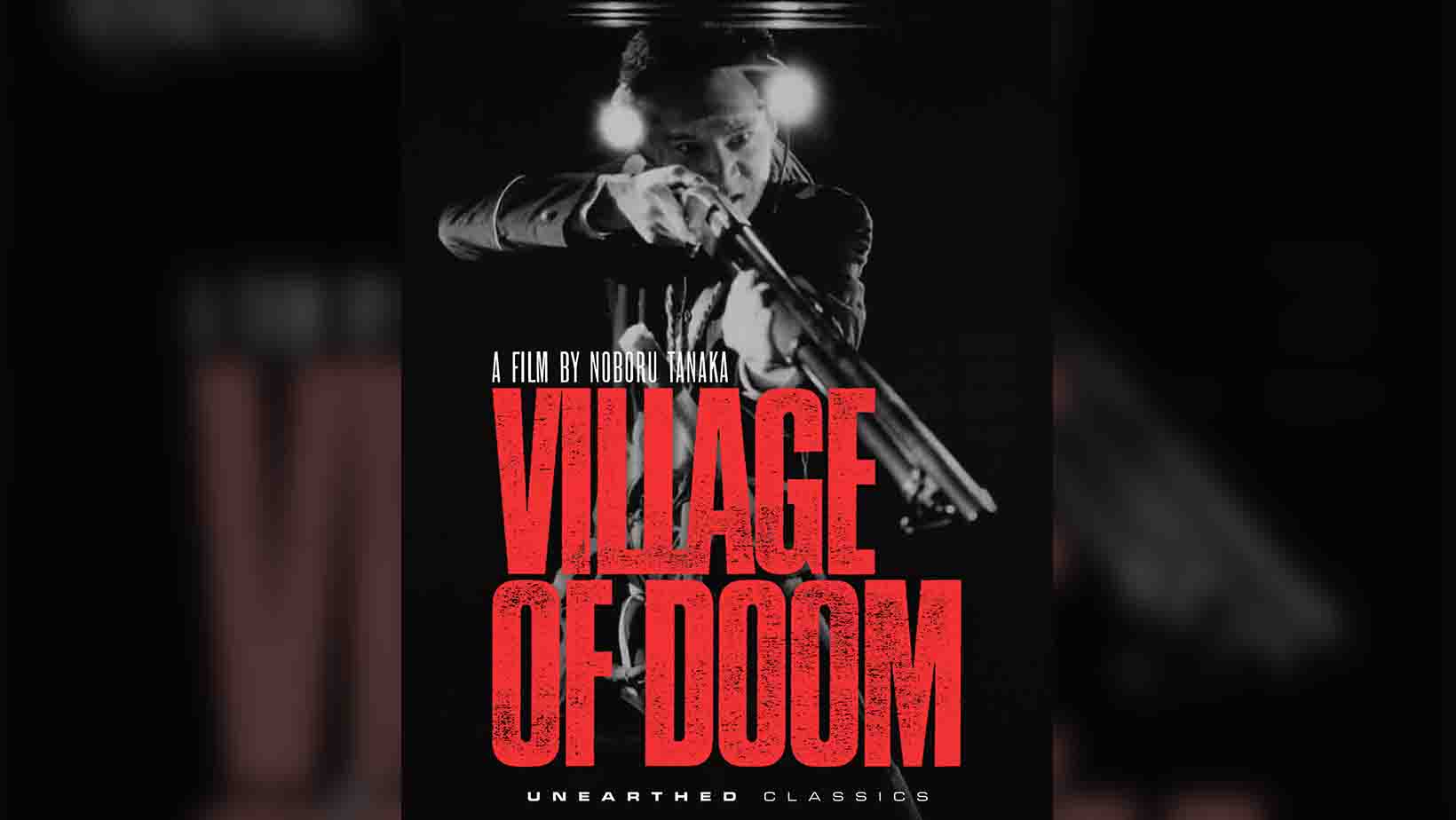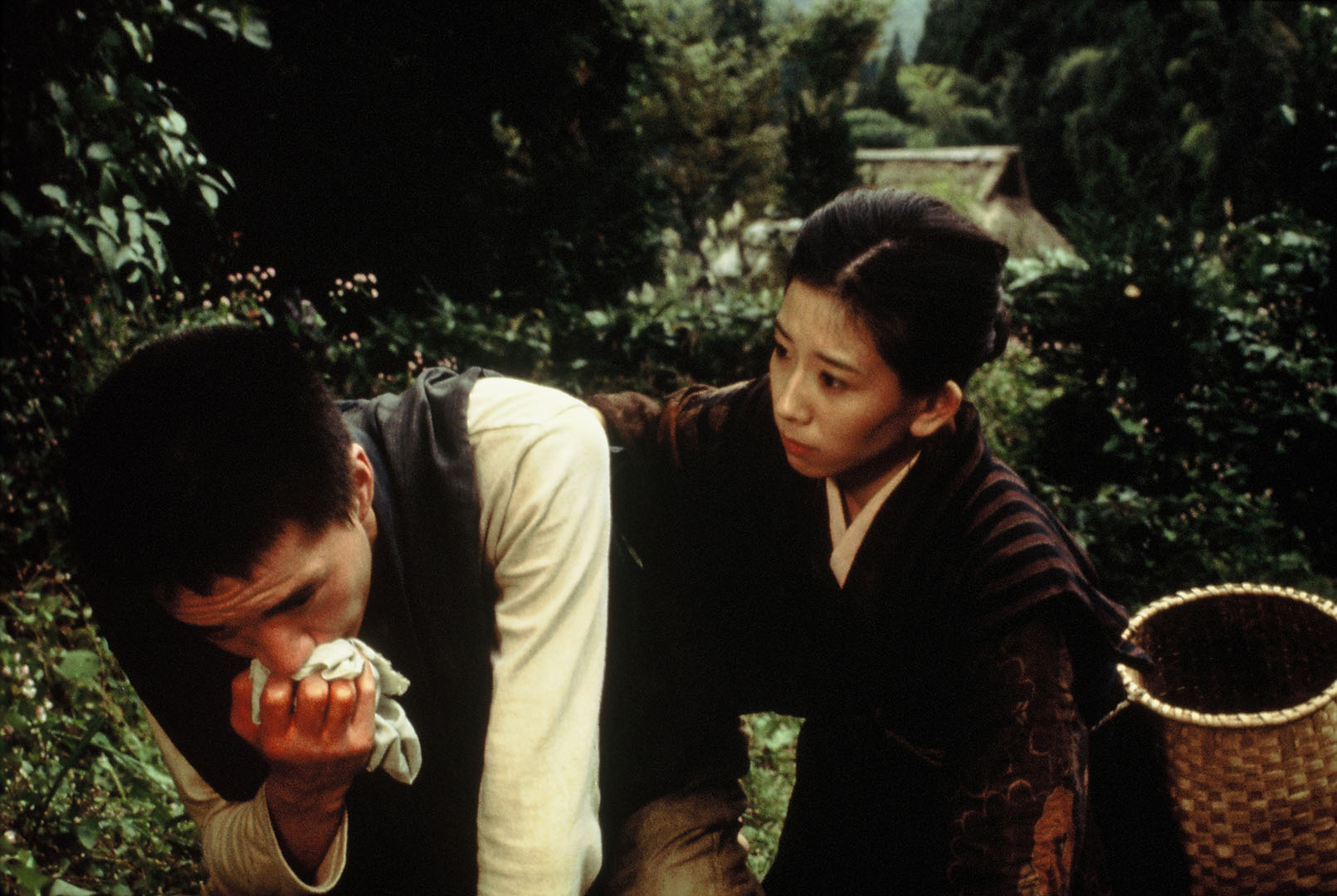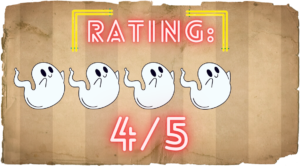

Village of Doom is a 1983 Japanese period crime thriller, written by Bo Nishimura and Takuya Nishioka, and directed by Noboru Tanaka. Primarily working as a Roman Porno director under Nikkatsu Studios, Tanaka began his directorial career with the softcore drama Beads from a Petal (1972) and continued to make many classic pieces of Nikkatsu’s memorable film catalog–such as (Maruhi) shikijô mesu ichiba (1974), Angel Guts: Nami (1979), and Rape and Death of a Housewife (1978).
After a diagnosis of tuberculosis prevents him from joining the military and serving in World War II, a young man becomes ostracised by the members of his small, rural village. As a result, the emotionally distraught man executes a spree of mass murder to take revenge on those who excluded him.

Based on the infamous real-life tragedy of the Tsuyama Massacre, Village of Doom is a visceral reenactment of the killing spree that occurred in Kamo, a small village near the city of Tsuyama, Okayama Prefecture on May 21, 1938. Mutsuo Toi, a 21-year-old man, who, after being diagnosed with Tuberculosis, goes on a brutal killing spree after being shunned by the entire village. Using a Remington M11/Browning Auto-5 shotgun, Katana, and axe, the perpetrator savagely murdered 30 people, injured 3, and took his own life in what is still considered one of the deadliest mass shootings in Japanese history.
Taking the time to construct its narrative organically, Village of Doom introduces the majority of its plot through naturalistic, character-driven interaction rather than a scrolling info dump like many true crime horrors of the time. The period, characters, and story are all introduced incrementally, weaving an intrinsically beguiling tale that will absorb its audience fully. Additionally, beginning with our protagonist’s life before his unfortunate diagnosis, the film’s themes of ostracisation and isolation hold more weight when introduced–effectively conveying the negative effects this has on Tetsuo’s psyche.

While Village of Doom is presented as a tragedy piece, Tanaka certainly hadn’t forgotten his roots in Roman Porno–featuring several scenes of softcore sex littered throughout the film. Furthermore, the third act provides an unhindered depiction of graphic violence as our protagonist’s killing spree begins–providing an overtly visceral rampage of bloody carnage. As such, the film undoubtedly resides closer to the pinku eiga/exploitation genre.
Although several of these murders happen off-screen, thanks to some effective cinematography and gruesome effects, these scenes are still depicted as undeniably ferocious. However, the majority of these cold-blooded acts are fully visualised, holding very little back in terms of brutality–murdering men, women, and children indiscriminately. From gunshot wounds, stabbings, and an impressive head explosion, these barbaric acts are actualised through some astounding practical special effects–unquestionably strengthening their impact.

A brutally realistic recreation of a historic mass shooting, Village of Doom’s blending of true crime, pinku, and exploitation culminates in an adroitly sanguinary experience overall. With fantastic performances, a slow-burning narrative, and grisly special effects, Tanaka’s masterful direction truly captures the horrors experienced that fateful night in 1938–sure to entice fans of both true crime and Japanese cinema.

Village of Doom (1983) can be purchased from Unearthed Film’s website here.
More Film Reviews
eROTik 2: The Beyond (2024) Film Review – A Moist Sphacelus of Blood, Puss, and Maggots
eROTik 2: The Beyond is a 2024 extreme horror film directed by Felice Santulli (better known as Slade Wilson), with Marylu’ Lallo working as assistant director. The film is a…
Post Mortem (2020) Film Review – Hungary’s International Breakthrough
Post Mortem (2020), Hungary’s first horror movie of international acclaim, is one of the best ghost stories I’ve ever watched. With scenes that rival Frances Ford Coppola’s ability to create…
The J-Horror Virus (2023) Documentary Review – How Japanese Horror went from Tape to Trend [Nippon Connection]
If you ask a Western horror fan, they can probably tell you exactly when they first heard about Hideo Nakata’s cult classic Ringu (1998). Whether it was due to the…
Bloody Sin (2011) Film Review – A Perfervid Love Letter to Exploitation
Bloody Sin is a 2011 English-language Italian extreme horror film, written and directed by Domiziano Cristopharo, with additional writing from Jay Disney and Filippo Santaniello. Being particularly well-known in the…
Visitors (Complete Edition) (2023) Film Review [Fantastic Fest]
Visitors (Complete Edition) is a Japanese 2023 Splatter horror comedy, written and directed by Kenichi Ugana. Beginning his theatrical debut in 2016 with the “Gal film” Ganguro Gals Riot (2016),…
Cross of the Seven Jewels (1987) – Maybe Everything is Bad, But Half A Werewolf is Better Than None at All
There are a lot of bad pants in this movie. Also, bad haircuts, bad sex and, whenever a chair is needed to hit someone over the head, or a table…

Hey there, I’m Jim and I’m located in London, UK. I am a Writer and Managing Director here at Grimoire of Horror. A lifelong love of horror and writing has led me down this rabbit hole, allowing me to meet many amazing people and experience some truly original artwork. I specialise in world cinema, manga/graphic novels, and video games but will sometime traverse into the unknown in search of adventure.


![The J-Horror Virus (2023) Documentary Review – How Japanese Horror went from Tape to Trend [Nippon Connection]](https://www.grimoireofhorror.com/wp-content/uploads/2024/06/j-horror-virus-2023-cover-365x180.jpg)

![Visitors (Complete Edition) (2023) Film Review [Fantastic Fest]](https://www.grimoireofhorror.com/wp-content/uploads/2023/09/Visitors-Complete-Edition-cover-365x180.jpg)
